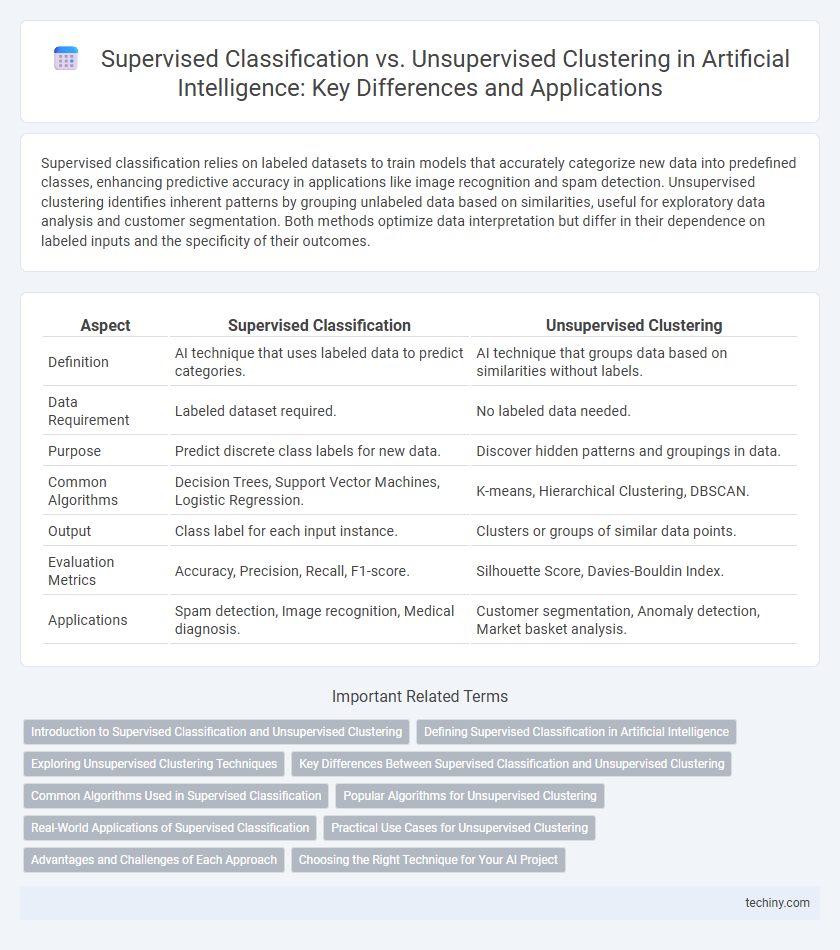Supervised classification relies on labeled datasets to train models that accurately categorize new data into predefined classes, enhancing predictive accuracy in applications like image recognition and spam detection. Unsupervised clustering identifies inherent patterns by grouping unlabeled data based on similarities, useful for exploratory data analysis and customer segmentation. Both methods optimize data interpretation but differ in their dependence on labeled inputs and the specificity of their outcomes.
Table of Comparison
| Aspect | Supervised Classification | Unsupervised Clustering |
|---|---|---|
| Definition | AI technique that uses labeled data to predict categories. | AI technique that groups data based on similarities without labels. |
| Data Requirement | Labeled dataset required. | No labeled data needed. |
| Purpose | Predict discrete class labels for new data. | Discover hidden patterns and groupings in data. |
| Common Algorithms | Decision Trees, Support Vector Machines, Logistic Regression. | K-means, Hierarchical Clustering, DBSCAN. |
| Output | Class label for each input instance. | Clusters or groups of similar data points. |
| Evaluation Metrics | Accuracy, Precision, Recall, F1-score. | Silhouette Score, Davies-Bouldin Index. |
| Applications | Spam detection, Image recognition, Medical diagnosis. | Customer segmentation, Anomaly detection, Market basket analysis. |
Introduction to Supervised Classification and Unsupervised Clustering
Supervised classification involves training algorithms using labeled datasets to categorize new data points based on learned patterns. Unsupervised clustering detects inherent groupings within unlabeled data by identifying similarities and differences without prior knowledge of classes. Both techniques are fundamental in machine learning, with supervised classification relying on annotated examples, while unsupervised clustering explores data structure autonomously.
Defining Supervised Classification in Artificial Intelligence
Supervised classification in artificial intelligence involves training algorithms on labeled datasets where input-output pairs guide the model to learn patterns for accurate prediction of categorical outcomes. This method relies heavily on annotated data to optimize decision boundaries, enhancing predictive accuracy in applications such as image recognition, spam detection, and medical diagnosis. Supervised classification contrasts with unsupervised clustering by utilizing predefined classes to enable precise model training and evaluation.
Exploring Unsupervised Clustering Techniques
Unsupervised clustering techniques such as K-means, DBSCAN, and hierarchical clustering enable the discovery of hidden patterns and groupings within unlabeled datasets, enhancing data exploration in artificial intelligence. These methods optimize feature space segmentation by grouping data points based on similarity metrics like Euclidean distance or density, without relying on predefined labels. Applications of unsupervised clustering include customer segmentation, anomaly detection, and image analysis, driving insights from complex, high-dimensional data.
Key Differences Between Supervised Classification and Unsupervised Clustering
Supervised classification relies on labeled datasets where algorithms learn to map input features to predefined categories, enabling accurate predictions on new data. Unsupervised clustering analyzes unlabeled data to identify inherent groupings based on feature similarity, facilitating data exploration without prior knowledge of classes. The key difference lies in the presence of labeled data for training in supervised classification versus the absence of labels and the focus on discovering hidden patterns in unsupervised clustering.
Common Algorithms Used in Supervised Classification
Common algorithms used in supervised classification include decision trees, support vector machines (SVM), k-nearest neighbors (k-NN), and logistic regression, all designed to categorize labeled data into predefined classes. Neural networks and ensemble methods like random forests and gradient boosting also play a significant role in improving classification accuracy. These algorithms leverage training datasets to learn decision boundaries and probabilistic models that enable precise labeling of new, unseen data points.
Popular Algorithms for Unsupervised Clustering
K-means, DBSCAN, and hierarchical clustering are among the most popular algorithms for unsupervised clustering, widely used for grouping unlabeled data based on similarity metrics. These algorithms differ in approach; K-means partitions data into k clusters by minimizing intra-cluster variance, while DBSCAN identifies clusters based on density, effectively handling noise and arbitrary shapes. Hierarchical clustering builds nested clusters through either agglomerative or divisive methods, enabling visualization via dendrograms and facilitating exploration of data structure at multiple granularity levels.
Real-World Applications of Supervised Classification
Supervised classification plays a crucial role in fraud detection by accurately categorizing transactions as legitimate or fraudulent based on historical labeled data. In healthcare, it enables precise diagnosis by classifying medical images and patient records to assist doctors in identifying diseases early. Furthermore, supervised classification optimizes email filtering systems by distinguishing spam from important messages, enhancing user experience and security.
Practical Use Cases for Unsupervised Clustering
Unsupervised clustering excels in customer segmentation, anomaly detection in network security, and market basket analysis by discovering hidden patterns without labeled data. It enables businesses to identify natural groupings in complex datasets, improving targeted marketing and fraud detection efficiency. This method is particularly valuable when predefined categories are unavailable or impractical to obtain.
Advantages and Challenges of Each Approach
Supervised classification offers high accuracy by leveraging labeled datasets, enabling precise predictions and clear model evaluation metrics like accuracy and recall; however, it requires extensive labeled data, which can be costly and time-consuming to obtain. Unsupervised clustering excels at discovering hidden patterns and data structures without labeled inputs, making it ideal for exploratory analysis, but it often struggles with interpretability and determining the optimal number of clusters. Both techniques present unique challenges: supervised methods depend heavily on quality labels, while unsupervised approaches may produce ambiguous results due to lack of predefined categories.
Choosing the Right Technique for Your AI Project
Supervised classification requires labeled datasets to train models that predict specific categories, making it ideal for tasks like email spam detection or medical diagnosis where outcomes are predefined. Unsupervised clustering analyzes unlabeled data, identifying inherent patterns and groupings, which suits exploratory data analysis or customer segmentation in marketing. Selecting the appropriate technique depends on data availability, project goals, and whether clear output labels exist, ensuring accurate model performance and relevant insights.
Supervised Classification vs Unsupervised Clustering Infographic

 techiny.com
techiny.com